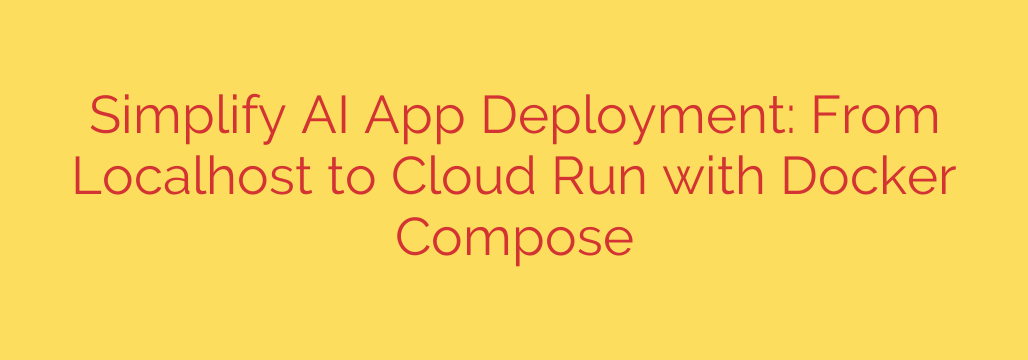
Streamlining AI Application Deployment: From Local Development to Cloud Success
Bringing an artificial intelligence project from a local environment to production can often feel like navigating a complex maze. You’ve built and tested your AI model locally, perhaps alongside other necessary services like a backend API or a frontend interface. Everything works perfectly on your machine, but preparing it for deployment on a scalable cloud platform introduces significant hurdles related to dependencies, environment consistency, and service orchestration.
Fortunately, tools exist to simplify this crucial transition. By leveraging containerization and orchestration, you can create a predictable, repeatable deployment process that minimizes headaches and accelerates your path to production.
The Challenge of Local vs. Production Environments
Developing AI applications often involves specific libraries, frameworks, and dependencies. What runs smoothly on your development machine might fail in a production setting due to subtle differences in operating system versions, installed libraries, or configuration. Furthermore, many AI applications consist of multiple interconnected services – perhaps a Python Flask backend serving predictions, a separate data processing worker, and a database. Managing these interdependencies during deployment is a significant task.
Introducing Docker and Docker Compose
This is where Docker and Docker Compose become invaluable.
- Docker allows you to package your application and all its dependencies (code, runtime, libraries, environment variables, configuration) into a standard unit called a container. This ensures that your application runs the same way regardless of the underlying infrastructure. Think of it as shipping your entire development environment in a box.
- Docker Compose is a tool for defining and running multi-container Docker applications. Using a single
docker-compose.ymlfile, you can configure all your application’s services, networks, and volumes. This file acts as a blueprint for your entire application stack, allowing you to spin up your complete multi-service environment with a single command locally.
Together, they provide environment consistency from development to testing to production.
Bridging the Gap to the Cloud: Leveraging Docker for Scalable Deployment
While Docker Compose is excellent for local development and testing, cloud platforms often require a different deployment model. However, the Docker images you build using your Compose configuration are the perfect building blocks for cloud deployment.
Managed services like Google Cloud Run are designed to run stateless containers. They automatically scale your containerized application based on request traffic, handling the underlying infrastructure management for you. The transition from your local setup using Docker Compose to a service like Cloud Run becomes much smoother because you’ve already done the hard work of containerizing your application and defining its dependencies.
The Simplified Deployment Workflow
The process using these tools looks something like this:
- Containerize Each Service: For each part of your AI application (e.g., the AI model serving API, the frontend), create a
Dockerfilethat specifies how to build its container image. - Define with Docker Compose: Use
docker-compose.ymlto define all your services, specify which Docker images they use (or how to build them), map ports, set environment variables, and define inter-service dependencies. Use this file for local development and testing. - Build and Push Images: Build your production-ready Docker images based on your Dockerfiles. Then, push these images to a container registry (like Google’s Artifact Registry or Docker Hub), making them accessible to your cloud platform.
- Deploy to Cloud Run: Configure a Cloud Run service to pull the specific Docker image for your main application service (e.g., the AI API). Cloud Run will manage instances of this container, scaling them up or down automatically. Other services defined in your
docker-compose.ymlthat are not stateless or suitable for Cloud Run might be deployed using other cloud services (like managed databases or persistent storage).
This approach effectively separates the concerns: Docker and Docker Compose handle the packaging and local orchestration, while the cloud platform provides the scalable, managed runtime environment for your containers.
Key Advantages
- Consistency: What works in your Docker container locally will work in the cloud container.
- Portability: Your container images can theoretically run on any platform that supports Docker containers.
- Simplified Dependency Management: All dependencies are bundled within the container.
- Scalability: Cloud Run automatically scales your stateless containerized services based on demand.
- Faster Iteration: A well-defined containerization process speeds up the build and deployment cycle.
Important Considerations for Cloud Run
Remember that Cloud Run is ideal for stateless services. If your AI application requires persistent data storage or stateful components, you’ll need to use separate managed services for those (like Cloud SQL, Firestore, or persistent disks mounted to other compute services) rather than relying solely on your docker-compose.yml definition for the entire production environment. However, the core application services built as Docker containers are perfectly suited for Cloud Run.
Conclusion
Moving your AI application from a local development environment to a production cloud service doesn’t have to be overwhelmingly complex. By adopting containerization with Docker and leveraging Docker Compose during development, you build a foundation for a much smoother transition. This approach provides the consistency, portability, and clarity needed to deploy your AI applications reliably on scalable platforms like Google Cloud Run, allowing you to focus more on innovation and less on deployment headaches.
Source: https://cloud.google.com/blog/products/serverless/cloud-run-and-docker-collaboration/








